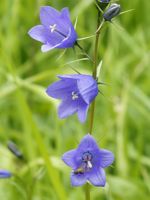Mon-Fri 9am - 5pm Mountain time
Harebell vs Beaked Sedge
Campanula rotundifolia
Carex utriculata
NOT AVAILABLE THIS SEASON - MIGHT RETURN
CUSTOM GROW
Harebell is a native perennial wildflower known for its bell-shaped, blue-violet flowers. The noddling blooms occur in clusters at the top of slender stems. Blooming in bursts from summer to fall, the flowers attract pollinators such as butterflies, bees, and hummingbirds.
Regular deadheading encourages additional blooms, extending its floral display through the season. Harebell prefers areas with cooler summer climates and does poorly in those that get too hot and humid. It is well suited for native wildflower gardens, pollinator gardens, and naturalization projects.
Beaked Sedge is a native perennial wetland plant that forms dense clumps of tall, grass-like stems. It produces distinctive beaked seed heads that mature from late spring into summer. The plant provides food for waterfowl, muskrats, and other wildlife, while its dense growth offers cover for birds and small mammals. Its flowers and seed structures contribute to pollinator and invertebrate habitat in aquatic ecosystems.
Thriving in saturated soils and shallow water, Beaked Sedge is common in marshes, fens, and riparian zones. Its rhizomatous growth enables it to spread into large colonies that stabilize soils and support overall wetland health. Hardy and low-maintenance once established, it is well-suited to riparian plantings, naturalization, and ecological restoration projects.

